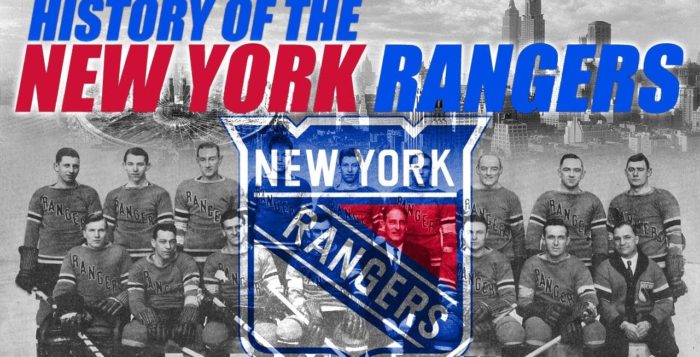This Day in Hockey History – August 19, 1947 – Make a Brand New Start of It in Old New York
The New York Rangers had won the Stanley Cup in 1940 but had not returned to the playoffs since 1942. Meanwhile, the Montreal Canadiens had won championships in 1944 and 1946 then lost the Final the following season. On August 19, 1947, with the Rangers rebuilding, they made a trade taking advantage of the Canadiens’ excess depth.
At the time of the trade, Dink Carroll wrote for the Montreal Gazette, “At first glance, it would seem that the Rangers have outsmarted the Habitants in this one, though conceivably it might not work out that way.” The very season of the trade proved that the Rangers indeed had made the better deal.
Montreal had sent two Stanley Cup winners, defenseman Frank Eddolls and center Buddy O’Connor, to New York. From their point of view, Eddolls had never lived up to his potential. They regretted trading Ted Kennedy to the Toronto Maple Leafs in return for him in 1943. After World War II service, Eddolls spent most of the 1944-45 season skating for the Canadiens, before being sent down to the Buffalo Bisons for the majority of the next two seasons. Apparently, they complained that his reflexes seemed too slow for the NHL.
The Rangers disagreed. They had wanted Eddolls a year before the trade went through. He became a solid defenseman for New York for five seasons, serving as their captain in 1950-51. They actually returned him to the Canadiens franchise after his playing career so that he could coach their AHL affiliate, the Buffalo Bisons. After being named AHL coach of the year, he took over as head coach of the Chicago Black Hawks for the 1954-55 season.
O’Connor was a six-year veteran of the Canadiens, who felt the 31-year-old was nearing the end of his career. He was still one of the most popular players, at every level, but he kept falling in the shadow of teammate Elmer Lach (even filling in on the “Punch Line” when Lach was injured). Carroll described him in the Montreal Gazette as “a bit of a will-o-the-wisp a graceful and rhythmic skater and a clever stickhandler.” In his first year with the Rangers, he scored 60 points in 60 games, ranked second (to Lach) in scoring. He became the first to win both the Hart Memorial Trophy (as MVP) and Lady Byng Memorial Trophy (for gentlemanly play) in the same season. At that time, he was even named Canada’s athlete of the year. O’Connor preceded Eddolls as team captain during the 1949-50 season. He retired in 1951 and went on to coach the Cincinnati Mohawks of the IHL. The Hockey Hall of Fame inducted O’Connor in 1988 in the (defunct) Veteran category.
On the other side of the trade, New York sent defenseman Hal Laycoe and two left wings, Joe Bell and George Robertson, to Montreal. None of them turned out to find much success there.
Laycoe, “a big, rugged rearguard,” was expected to be sent to Buffalo at first, and he did spend much of the first season there. After another three seasons struggling to get ice time in Montreal, Laycoe was traded to the Boston Bruins on Valentine’s Day in 1951. He played much more there, and became famous for his fight with Canadiens star Maurice Richard that led to the Richard Riot. He retired from the Bruins in 1956.
Canadiens GM Frank Selke had hopes that Bell would play better for them than the Rangers. “He’s not a particularly aggressive player. He’s more of an opportunist – the type that trails the play in on the nets and pots the puck. If he is teamed with strong players like Lach and Richard he might get a lot of goals for us.” As it turned out, Bell never played a game with the Canadiens. He spent two seasons with the Buffalo Bisons and then played in various minor leagues until 1956. All in all, he had only played 15 games for the Rangers in 1942-43, served in the war, and then played the 1946-47 season. That was the extent of his NHL playing career.
As for Robertson, he was still developing at the time of the trade. He was meant to tryout with the Montreal Royals of Quebec Senior Hockey League and join the NHL in another year or two. He played one game with the Canadiens in 1947-48 and 30 the following year. Like Bell, he then played in minor leagues until 1956.
On a team level, the Rangers had some conflict because Lester Patrick did not agree with GM Frank Boucher’s decision to conduct the trade. However, they made the playoffs right away. In 1950, the Rangers played for the Stanley Cup only to lose the Final. On the flip side, the Canadiens missed playoffs for the only time in many years that first season. However, they soon returned to the top again, making the finals ten consecutive seasons between 1951 and 1960, winning six of them.
Additional Sources:
- Dink Carroll, “Playing the Field,” and “Canadiens Trade O’Connor and Eddolls to Rangers,” Montreal Gazette, 20 Aug. 1947, p. 14.
- “Roundup Of Sports,” New York Daily News, 20 Aug. 1947, p. 62.
- John Kreiser and Lou Friedman, The New York Rangers: Broadway’s Longest Running Hit (Sports Publishing LLC, 1996), 94-95, 108.
- http://nyrangerslegends.blogspot.com/2009/01/frankie-eddolls.html














